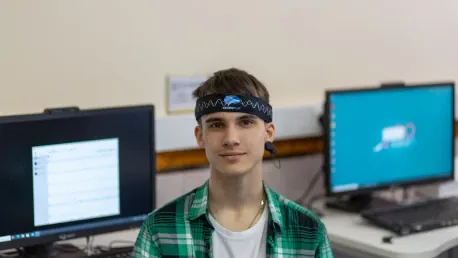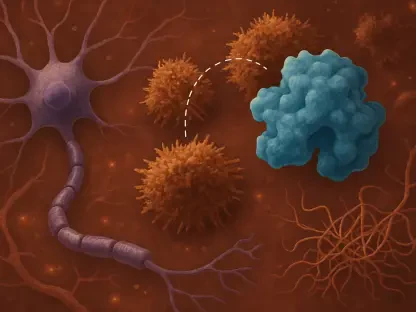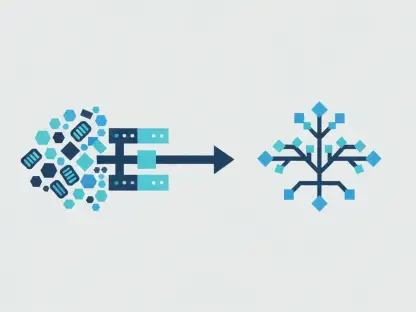The field of electroencephalography (EEG) has witnessed a groundbreaking shift as researchers at the University of Texas at Austin have developed a biocompatible liquid ink that can be printed onto the scalp to measure brain activity. This new technology promises to revolutionize the traditional EEG process, which currently involves attaching multiple wired electrodes to a patient’s scalp in a time-consuming and uncomfortable manner. Published in the journal Cell Biomaterials, this innovation offers a more efficient and less intrusive alternative, marking a significant leap forward in the diagnosis and monitoring of neurological conditions.
Advancements in EEG Technology
Traditional EEG Process and Its Limitations
Electroencephalography, a critical tool for diagnosing neurological disorders such as epilepsy, brain injuries, seizures, and brain tumors, has long relied on a cumbersome and labor-intensive process. The traditional method entails technicians meticulously positioning and gluing electrodes to the scalp, often causing discomfort and consuming valuable time. Furthermore, these electrodes are connected by multiple wires, which can inhibit patient movement and introduce signal interference. Despite its effectiveness, the inconvenience and invasiveness of this process have long been pain points for both patients and healthcare providers.
Lu and her team at the University of Texas at Austin sought to address these challenges through the development of “electronic tattoos” or e-tattoos. These small, skin-printed sensors are designed to monitor various bodily signals more comfortably and accurately than traditional methods. Previous e-tattoo designs had been limited to hairless areas of the body, thus posing a challenge for applications on the scalp. To overcome this obstacle, the researchers formulated a conductive polymer-based liquid ink capable of penetrating hair and forming thin-film sensors directly on the scalp, heralding a new era of EEG technology.
Innovation in Sensor Application
The application of this innovative e-tattoo technology is executed using a computer algorithm that precisely identifies the optimal locations for the EEG sensors. Once these locations are determined, a digitally controlled inkjet printer applies the conductive ink to the determined spots, ensuring a quick, non-contact, and pain-free process. This innovative method has been tested on five participants with short hair, and the results showed that e-tattoos were comparable to conventional electrodes in detecting brainwaves. Additionally, the e-tattoos provided the added benefit of minimal noise interference, enhancing the accuracy and reliability of the readings.
Unlike traditional EEG electrodes, which typically begin to fail after six hours due to drying gel, the e-tattoos maintained stable connectivity for at least 24 hours. The researchers also modified the ink to create lines extending from the sensors to the base of the head. This eliminated the need for long wires between the electrodes and the brainwave data collection device. These advancements result in shorter physical connections, improving patient comfort and reducing the risk of signal errors caused by tangled or poorly connected wires.
Future Implications for EEG and BCI Applications
Integration of Wireless Capabilities
Looking ahead, the research team plans to integrate wireless data transmitters into the e-tattoos, which could facilitate fully wireless EEG monitoring. This would not only further streamline the EEG process but also reduce the need for patients to remain tethered to a data collection device. Wireless capabilities would enable greater mobility and comfort for patients undergoing EEG tests, making the process more accessible and less burdensome. The potential for wireless EEG systems could transform both clinical and research settings, allowing for more naturalistic observations of brain activity in various environments.
Moreover, this novel approach sets the stage for advancements in brain-computer interface (BCI) applications, where brain activities related to specific functions like speech or movement are recorded to control external devices. Traditionally, BCIs rely on cumbersome headsets that can be uncomfortable and restrictive. The development of e-tattoos simplifies this technology by allowing the necessary electronics to be printed directly onto a patient’s scalp, making the process less intrusive and more user-friendly. This innovation holds promise for a wide range of applications, from medical diagnostics to advanced neurotechnology.
Broader Impact on Neurological Research
The field of electroencephalography (EEG) has experienced a revolutionary breakthrough thanks to researchers at the University of Texas at Austin. They’ve developed a biocompatible liquid ink that can be printed directly onto the scalp to measure brain activity. This cutting-edge technology is poised to transform the traditional EEG process, which currently requires attaching multiple wired electrodes to a patient’s scalp, an often time-consuming and uncomfortable procedure. The findings, published in the journal Cell Biomaterials, provide a more efficient and less invasive alternative, representing a significant advancement in the diagnosis and monitoring of neurological conditions. This new method not only simplifies EEG procedures but also improves patient comfort and the accuracy of readings, making it a valuable tool in both clinical and research settings. The potential applications extend beyond conventional EEG uses, opening doors for more extensive and varied neurological studies, ultimately contributing to a better understanding and treatment of various brain disorders.









